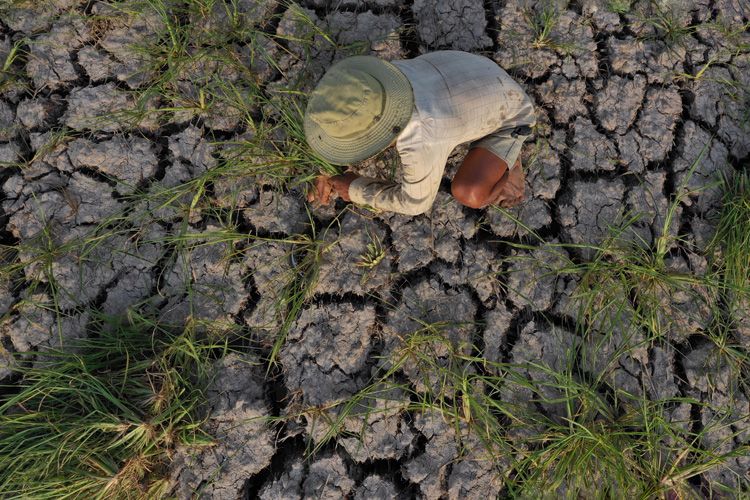American experts are recommending that countries in the lower Mekong pay China, via insurance representatives, to release water during the dry season.
“Countries in the lower basin Mekong River could make financial contributions to create a fund that offsets financial loss to China and ask Beijing to release water in dry season,” Alan Basist, Mekong Dam Monitor Co-Lead, said in at a virtual event titled “Where’s the Water: Mekong Dry Season 2022” hosted by the Stimson Center Tuesday.
Basist, president, Eyes on Earth, a partner of the Stimson Center in operating Mekong Dam Monitor, which is partly-funded by the U.S. State Department, explained that downstream countries can take assistance from a representative in the insurance industry to proceed with such a plan.
Citing his experience in working with insurance partners for over a decade, Basist suggested that when a drought situation is identified, an insurance agency representing downstream countries would offer to pay China for releasing water that it holds in its dams upstream of the Mekong River.
Basist explained this kind of payment could be seen as compensation for China because it would have to releases water instead of holding to generate electricity during the dry season, leading to financial losses.
In effect, it would mean that China is asked to let water in its reservoirs flow naturally downstream, maintain the integrity of the Mekong and welfare of the communities that depend upon it during the dry season.
“This kind of insurance arrangement has been done in different parts of the world successfully. Therefore, downstream countries could consider it (a form of) cooperation in sharing the water resource of Mekong.”
Brian Eyler, Southeast Asia Program Director and Mekong Dam Monitor Co-Lead, Stimson Center, said he had discussed with Basist the “compensation” issue, given the fact that half of the Mekong water storage is in China and the easiest solution for obtaining downstream relief is cooperation with China.
“However, China has not come up with a cooperative plan with downstream countries on how to respond in times of need. It might actually be the most difficult (one), but it still is a solution.”
 |
|
A drought hit rice field in Ben Tre Province, Vietnam’s Mekong Delta, March 2020. Photo by VnExpress/Huu Khoa |
‘Sudden shocks’
Eyler noted that Jinghong, China’s closest dam to downstream countries, recently released and restricted water suddenly in areas along the Thailand and Laos borders. It caused not just a gradual rise of the river, but “sudden shocks” to the river level.
In 2021, there were 22 times when upstream dams in China administered such sudden shocks, increasing river water levels by more than 50 centimeters, or decreased the level by as much.
One of the major concerns, Eyler said, was the adverse ecological impacts that this would have, including existential threats to critically endangered species. The destruction has already been seen in the form of bird nests alongside the river destroyed, giant fish flushed out and trees dying in large numbers.
Comparing data between 2018 and 2020, Eyler said China’s dams operated the same way regardless of the conditions downstream, taking a larger amount of water out of the river.
“This is very concerning.”
He said China has completed 129 dams on the river, 11 of them the largest mainstream dams. Most of the Mekong water, as much as 56 percent, is held in China.
Cooperation is key
Nguyen Huu Thien, an independent consultant based in Can Tho, a city in Vietnam’s Mekong Delta, said climate change has complicated the Mekong system, but hydropower dams will make it even more so. In the context of climate change, countries will see more extreme events like El Nino and La Nina where rainfall is low and then hydropower dams do not have sufficient water to run their turbines.
Basist stressed that countries along the Mekong River not only sees lower water flow because of dams but also a huge impact from the lack of rainfall and snowmelt that would occur during the wet season. Climate change has shown significant negative impacts over the last several years. In addition, land use is another factor affecting water flow.
Therefore, he said, related countries are dependent upon cooperating with each other to solve relevant problems. They need to start looking at it as an integrated system, not just who can hold water back for purposes that benefit their own country. Countries need to promote communication and understanding to figure out how to effectively work together and maintain the integrity of the river.
Cooperation is the key for such management, he added.
- Reduce Hair Loss with PURA D’OR Gold Label Shampoo
- Castor Oil Has Made a “Huge” Difference With Hair and Brow Growth
- Excessive hair loss in men: Signs of illness that cannot be subjective
- Dịch Vụ SEO Website ở Los Angeles, CA: đưa trang web doanh nghiệp bạn lên top Google
- Nails Salon Sierra Madre
 VnExpress News The News Gateway of Vietnam
VnExpress News The News Gateway of Vietnam





